13 Solitaire Strategies to Win the Game
By Neal Taparia - Last updated: 11/18/2025
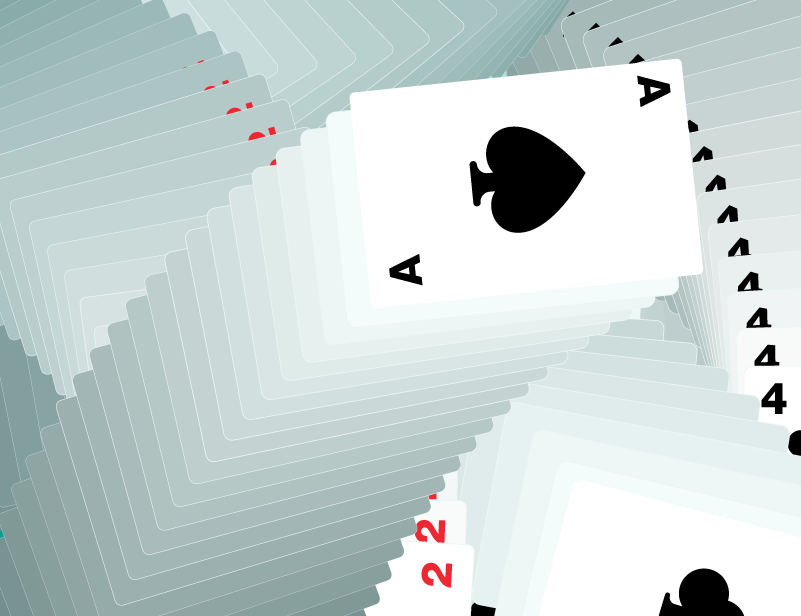
Playing Solitaire can be a lot of fun, especially when you win! But if you find yourself losing more than you are winning, you might need a refresher on Solitaire rules.
Once you have the basic rules down, adding Solitaire strategy to your gameplay will help increase your win rate. Because the game constantly changes, so must your strategy, so we’ve put together the 13 best Solitaire strategies that can help you win the game.
1. Draw from the Stockpile First
Before you even begin to look at the tableau, turn over the first card from the stockpile to have a better context for play. You can only move cards that are face up, and by turning over the first card from the stockpile into your waste pile, you now have an additional face-up card to coordinate your moves.
Having this additional card at your disposal means you can better survey the tableau and see how the waste pile card might impact your movements. Turning over the card doesn’t mean you should play it right away. It just reveals more facedown cards so you can plan moves that may create a cascade of plays.
You can even cycle through the entire stockpile first to see all the cards in the stockpile. Just remember that in online Solitaire you receive a total score calculated by the number of moves and time to complete the game. If you’re trying to beat your best Solitaire score and make it on the leaderboard, you want to be mindful of how much you use the stockpile because every card you turn over from the stockpile counts as a move.
2. Survey the Tableau Before You Move Cards
Your initial tableau doesn’t necessarily indicate a winning or losing hand. When you play, your goal is to always give yourself the most opportunities to move cards strategically, and you can’t do this if you don’t assess the tableau and consider the possibilities for play.
This initial assessment allows you to anticipate your needs and quickly identify possible trouble spots, such as several low cards showing, which means fewer cards can be added to them. From there, you can plan for ways to keep the cards moving and start to think multiple moves ahead.
While this is essential to do at the start of the game, you should always survey the tableau before you make a move, since the tableau’s layout, the number of facedown cards left to play, and more change with every move you make. Then you can weigh different strategies to see which one fits the situation best.
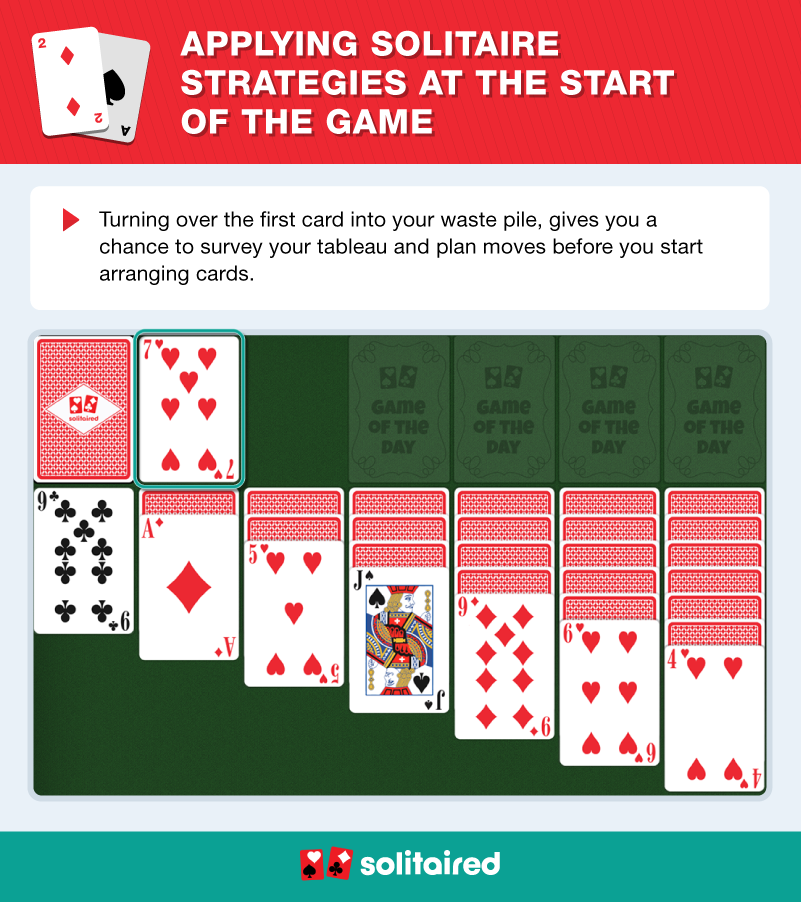
3. Plan Your Moves
Every time you take stock of your tableau, go over various scenarios for moves. Often you’ll have more than one move you can make, and it’s important to not just look at the one card you can move but to look at how that move impacts the entire tableau.
While planning your moves may seem like a basic strategy, it’s one that you easily lose grasp of while playing, especially if you’re playing to beat a certain time. But planning your moves helps you to arrange your cards purposefully to open up more moves, not just for immediate gains.
For example, perhaps you think you should move a black five onto a red six so that you empty a column, but you have no king waiting to place in the empty spot. That may give you an immediate gain of playing one card, but that empty column costs you a move for nothing since you gain no future moves without a king ready to be placed in the column.
4. Prioritize Moves That Reveal Facedown Cards
Even when it seems counterintuitive, you must make moves that help you to gain more face-up cards. You can only move face-up cards when playing Solitaire, and because all cards must be played onto the foundation piles to win, you need to get to the facedown cards as quickly as possible.
If the black six in your tableau can move to its foundation pile or on top of a red seven in the tableau, at first glance, you may think the best move is to the foundation pile. After all, getting all the cards to their respective foundation piles means you win the game, but those decisions aren’t always so simple.
If you also have a red five on top of facedown cards, moving your six to the foundation pile means you miss the opportunity to reveal the facedown cards. The best move is to play the five on the six, and then move the six to seven.
5. Zero In on Deep Columns
Focusing on deep columns of hidden cards takes the strategy of revealing facedown cards one step further. Stockpile cards are facedown cards, but you can cycle through those and use them as needed. But deep columns take several moves before you discover all the cards hiding beneath the top face-up card.
So, for example, if you have two red fours and just one black five, always play the red four that is covering the most facedown card to give you the best opportunity to play. While moving a long column of revealed cards may seem like a better move than just a column with two face-up cards, always move the column that gives you access to more hidden cards, even if you’re just moving two face-up cards.
It’s not the amount of cards you’re moving but the amount you can possibly reveal that’s important. Aces, kings, and other cards you need to create plays could be hidden deep within facedown columns.
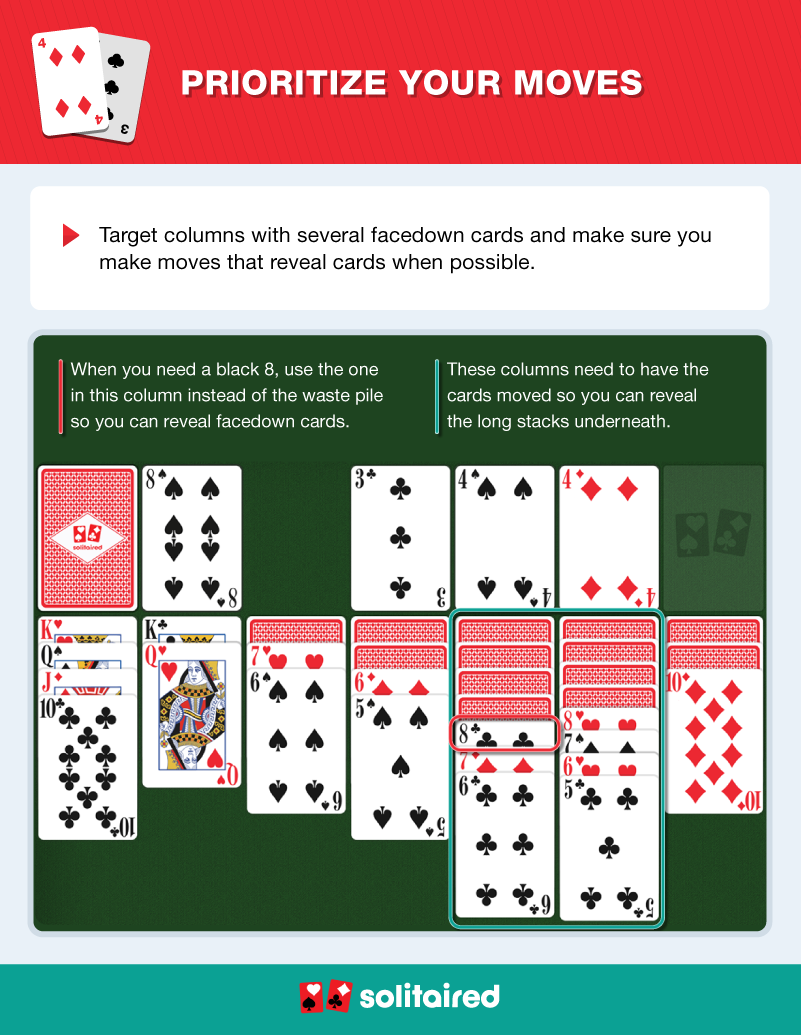
6. Remember Cards in the Stockpile
One of the easiest ways to reveal facedown cards is to look at all of the cards in your stockpile. As you play, keep track of your stockpile cards when cycling through them. Remembering the hidden cards means you can access them when you need them.
You can also cycle through the stockpile more than once if you want to keep track of important cards, but that can play against you if you’re trying to win in the least amount of moves. Every time you flip a card from the stockpile into the waste pile, it counts as a move. So cycling through just to get to a specific card adds extra moves to your total.
7. Move Aces and Twos to the Foundation Piles
Get your aces and twos to the foundation piles immediately. You need aces to begin the foundation piles, and nothing can be played on top of a two. So keeping these in your tableau stifles your moves. On the other hand, getting these cards to your foundation piles helps remove them from the tableau, and moving them likely reveals facedown cards that help to open more opportunities to play.
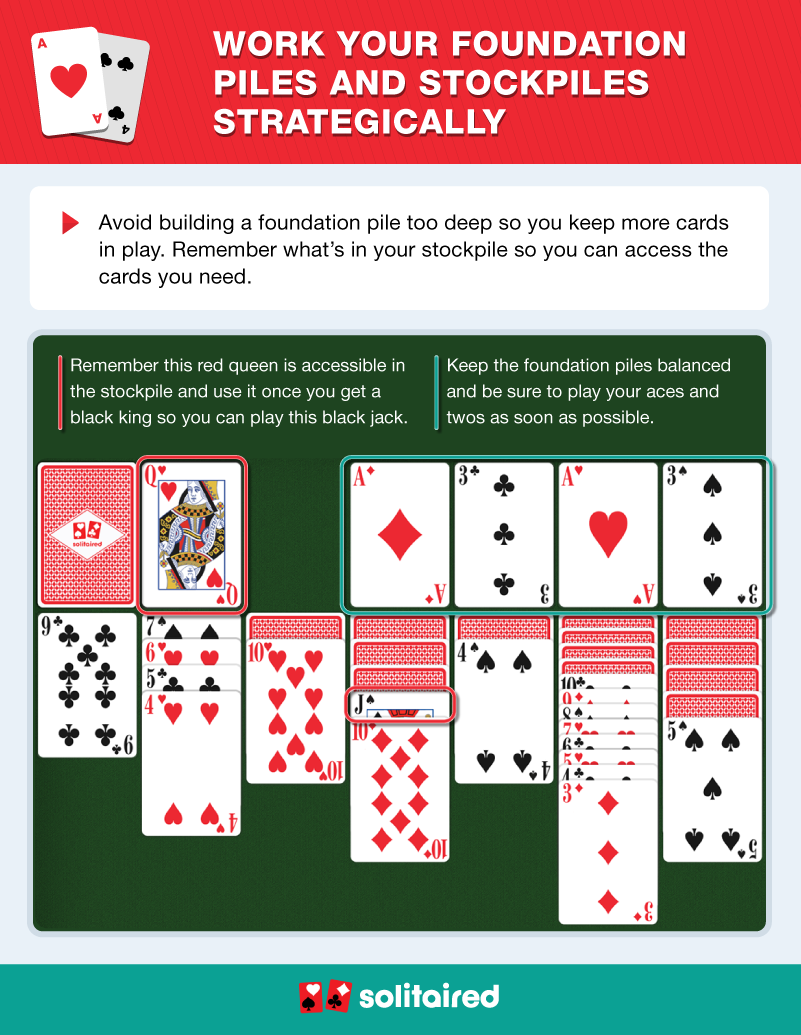
8. Build Even Foundation Piles
Although playing aces and twos right away are important, don’t get too eager with the foundation piles. Building single foundation piles up too quickly past twos can actually hurt your ability to make future moves.
Consider how you build columns in the tableau—you descend in rank and alternate colors—so you are dependent on using all the suits. That means every card you play in foundation piles is one you can’t use to build a column. Building foundation piles evenly keeps necessary cards in play. Instead of playing multiple cards of one suit into the foundation pile, try to play equal ranks on each foundation pile.
For example, if you continue putting clubs in their foundation pile, and you’ve built it up to the rank of seven, you just cut your chances in half of getting any playable black cards from two to seven when you need them.
To make quick assessments easily, check what the lowest rank of one color is in the foundation piles. Then don’t play any card of the opposite color onto foundation piles that is more than two ranks higher. For example, if you have a three of hearts and four of diamonds at the top of their foundation piles, then the lowest rank is three for red cards. So don’t play any black card onto foundation piles that ranks higher than five to ensure you keep cards in play that you need.
9. Empty a Column Only When You Have a King
Clearing cards out of columns may seem like a good move, but empty columns do you no good unless you have a king to fill them. Only kings can go into empty columns so if you remove all the cards, you’ve essentially made moves only to cut yourself down to six columns of play.
For example, if you have a red eight faceup as the last card in the column and you can move it to a black nine, don’t be too quick to move that eight unless you have a king handy to play in the empty column. Keeping the eight where it is won’t stop your moves in the game. If you have a black seven, you can move it onto the red eight in the near-empty column, but moving the eight and creating an empty column wastes a move.
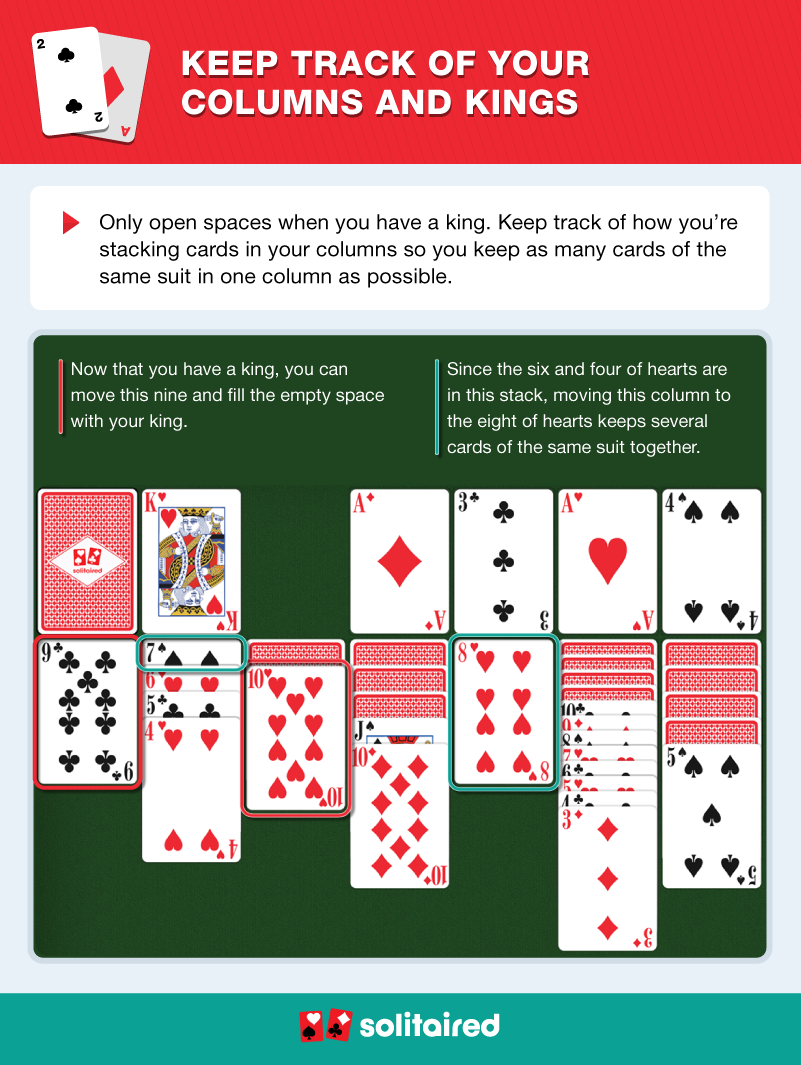
10. Arrange Columns with Matching Suits
Columns in the tableau have to alternate in color, but keeping matching suits in columns helps make it even easier to keep your foundation piles built evenly. For example, try to focus on keeping the black cards clubs in one column and spades in the other, and try to keep hearts in one column and diamonds in the other.
While you won’t be able to do this perfectly, the more you can do it, the more easily you can keep your foundation piles moving at the same pace. So, for example, if your column has a nine of clubs followed by an eight of diamonds, try to use a seven of clubs if possible instead of the spade.
11. Keep Track of Colors While Stacking
You have to alternate colors in columns, but when, for instance, you play a king, you get to control the colors you play. Before playing a red or black king into an empty space, assess the tableau and consider the cards you’ve seen in the stockpile.
If you begin with a king spades, then the queen and all even numbers will need to be red. On the other hand, if you begin with a king of hearts, the queen and all even number will need to be black. So consider what playable cards you can stack into the new column, and play the king that offers the most moves.
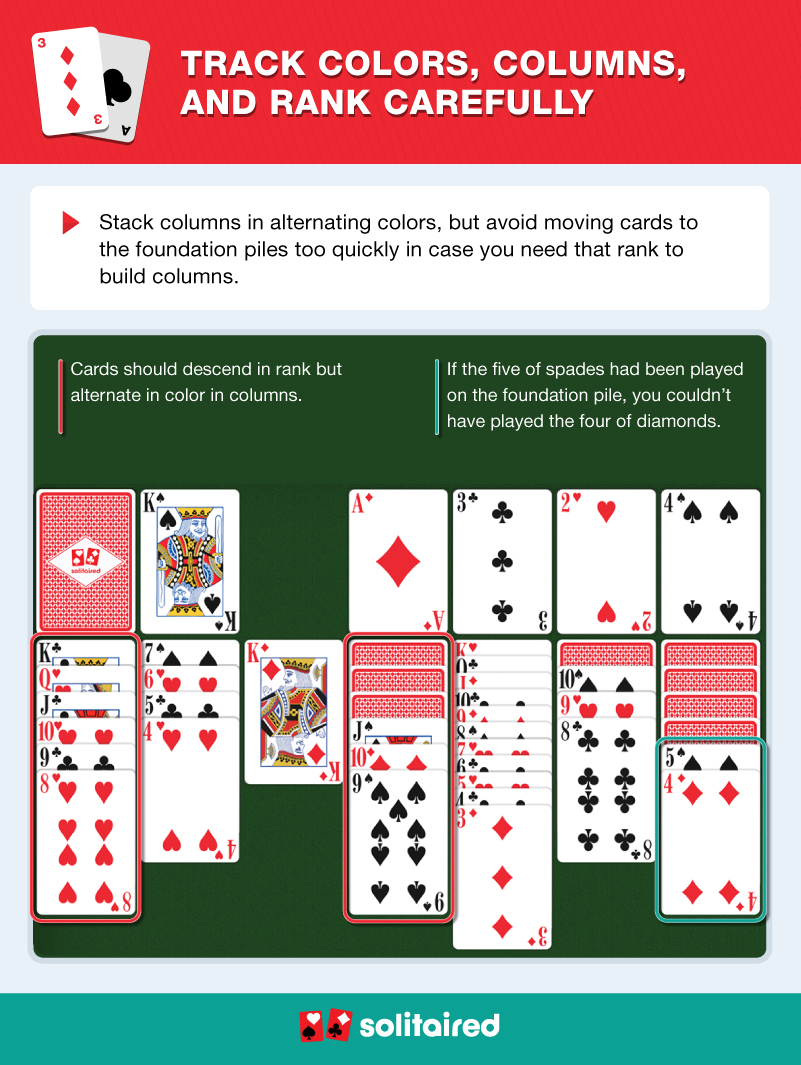
12. Don’t Move Cards to Their Foundation Piles Too Quickly
Playing all your cards onto the foundation piles means you win, but that doesn’t mean you should always play cards onto those piles when given the opportunity, especially early in the game. Because you need to reveal facedown cards to make them playable, you need as many playable cards as possible to keep the game going.
The only cards that aren’t necessary in your tableau are aces and twos. Nothing can be built on a two, but all other cards can be used to build columns. So focus on building columns and revealing facedown cards more than building foundation piles at first.
You won’t ruin any plays by simply building columns, and then once you have some substantial columns set up, start playing unnecessary cards evenly onto their foundation piles.
13. Use the Undo Button When Needed
Sometimes you make a mistake, and that’s okay. Whether you make a single move and discover that you should have played another card instead or you make a few moves and realize that path only gets you stuck, you can undo your moves by clicking the “Undo” button.
Just remember that the “Undo” button counts as a move, and if you’re playing to win in the least amount of moves, use the button sparingly. If you use the button to undo a single move, you actually cost yourself three moves in the process —one for the original move, one for the “Undo” button, and one for the new move.
Is Every Game of Solitaire Winnable?
Even when you use the best strategies, you simply can’t win them all, but most games are winnable. However, other variations might prove to be more difficult. The easiest versions are Classic or Klondike Solitaire, and after looking at 2,898,974 random Solitaire Turn 1 games played on our site, we found that 955,805 (33.0%) were won. When it comes to Turn 3 Solitaire, which is considered medium in difficulty, the win rate was 11.1%.
Even if you don’t get the satisfaction of winning every game, playing Solitaire offers many other benefits. Besides enjoying the game play, you can calm your mind and improve your memory, and if you’re looking for a way to relieve stress and anxiety, playing Solitaire can help.
Challenge Yourself with a Game of Solitaire
Once Solitaire gets too easy, trying different variations like FreeCell and Spider Solitaire can help you further develop your strategic thinking and flex your mental skills. Whether you want to have some calming alone time or are looking for a new game to play, use Solitaired to play free, unlimited online Solitaire games on your phone, desktop or play another variation from our extensive library of games.
About the author

